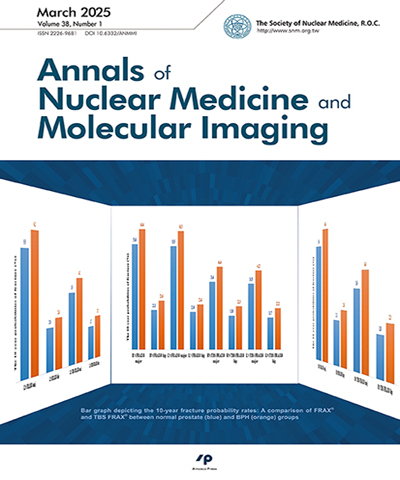
核子醫學暨分子影像雜誌/Annals of Nuclear Medicine and Molecular Imaging
中華民國核醫學學會 & Ainosco Press,正常發行
選擇卷期
- 期刊
Background: This study was conducted to explore the effectiveness of soy milk, rice milk, and full-fat milk in reducing sub-diaphragmatic activity in patients undergoing technetium-99m-sestamibi (Tc-99m MIBI) myocardial perfusion imaging (MPI). In daily practice, high-fat foods or milk is recommended to release cholecystokinin, which results in increased biliary evacuation of the gallbladder, thereby leading to reduced interfering sub-diaphragmatic activity. However, milk may cause discomfort in patients with lactose intolerance. Therefore, this study explores the feasibility to replace dairy products with soy milk or rice milk, which is commonly consumed by Asians. Methods: Ninety patients who underwent MPI were randomized into three groups: (A) 200 mL of full-fat milk, (B) 200 mL of soy milk, and (C) 200 mL of rice milk. Semi-quantitative grading of the relative intensity of sub-diaphragmatic activity compared to myocardial activity was evaluated. The image variability was visually determined based on the reconstructed images. The rate of reduction of sub-diaphragmatic activity in different groups was evaluated. Results: Drinking soy milk showed no statistically significant difference compared to full-fat milk with both semi-quantitative and image variability analyses (p > 0.05). The ability of rice milk to reduce sub-diaphragmatic activity was lower than that of full-fat milk (p = 0.04) in semi-quantitative grading; however, image variability analysis showed no significant difference (p = 0.22). Semi-quantitative and image variability analyses showed that the ability of rice milk to reduce sub-diaphragmatic activity was lower than that of soy milk. Conclusions: This study confirms that both soy milk and rice milk can reduce sub-diaphragmatic activity and assist in the diagnosis of myocardial ischemia of the inferior and inferoseptal walls of the left ventricle. Soy milk showed greater reduction than rice milk and can be a good alternative to full-fat milk in Tc-99m MIBI MPI, especially in regions with high lactose intolerance prevalence.
- 期刊
背景:本篇研究進一步要瞭解良性攝護腺肥大(benign prostatic hyperplasia, BPH)與腰椎骨質密度(bone mineral density, BMD)增加是否與骨小樑增加有關。方法:本篇研究利用回溯性研究方式進行分析,收集來自臺灣南部某區域教學醫院,受檢者於本院預防醫學中心接受健康檢查受檢者,收集時間從2014年6月至2020年12月,收集年齡區間為50~98歲男性,排除癌症患者、實驗室數據資料不完整、BMD有任何一個區域部位無法量測,我們即排除不納入本研究。最終收集4,697位受檢者納入本篇研究,利用彩色Doppler超音波影像判斷,分成正常組與BPH組。結果:共計收集4,697位個案,年齡50~98歲間受檢者,平均年齡61.73± 7.59 years,身高166.38 ± 5.80 cm,體重68.73 ± 9.94 kg,身體質量指數24.80 ± 3.13 kg/m^2,平均骨小樑指數(trabecular bone score, TBS)1.374± 0.088。平均腰椎BMD為0.983 ± 0.156 g/cm^2,平均右側股骨頸BMD為0.712 ± 0.113 g/cm^2,平均右側全髖BMD為0.884 ± 0.126 g/cm^2,平均左側股骨頸BMD為0.719 ± 0.113 g/cm^2,平均左側全髖BMD為0.854 ± 0.126g/cm^2,TBS為1.374 ± 0.088。最後發現,腰椎BMD區域,BPH組為正常組的1.068倍,有顯著(p = 0.038),但腰椎TBS,BPH組為正常組的1.033倍,但無顯著(p = 0.324)。結論:本篇新發現腰椎BMD增加,並不是由於骨小樑增加,是否因乃增加皮質骨還要進一步研究,針對BPH疾病對於BMD影響也可以利用TBS來做另類評估。
- 期刊
背景:放射線肺炎為病患接受胸腔放射治療後常見的併發症,文獻指出氟-18去氧葡萄糖正子電腦斷層檢查(fluorine-18-fluorodeoxyglucose positron emission tomography/computed tomography, F-18 FDG PET/CT)除了腫瘤細胞有高度攝取葡萄糖的情況,發炎的正常組織亦會有FDG代謝增加,可偵測其發炎反應。本研究目的為應用FDG-PET/CT評估食道癌患者經放射治療後之腫瘤反應與肺臟發炎變化。方法:本研究回溯收集25位接受新式弧形放射治療之食道癌病患放射治療計畫及治療前(pre-RT)與治療後(post-RT)的FDG-PET/CT影像,利用放射治療計畫軟體將放射治療計畫之CT影像分別與治療前與治療後之FDG-PET/CT影像對位及融合後,即可取得腫瘤和正常組織之劑量分布及PET/CT的代謝數值。將肺臟區分為≥ 5 Gy高劑量區(high dose, HD)及< 5 Gy低劑量區(low dose, LD)後,量化分析pre-RT與post-RT之肺臟位於高劑量區與低劑量區之FDG-PET/CT代謝數值前後變化,包括標準攝取值(standard uptake value, SUV)、最大標準攝取值(maximum standard uptake value, SUVmax)、平均標準攝取值(mean standardized uptake value, SUVmean)、病灶組織糖解值(total lesion glycolysis, TLG)及全肺糖解值(global lung glycolysis, GLG)等。結果:本研究分析25位食道癌病患在放射治療後與治療前相比,腫瘤病灶區域的SUV max(下降63 %)、SUVmean(下降48 %)、TLG(下降76%)皆有顯著變化(all p < 0.05)。在治療後肺臟高劑量區的SUVmax(上升23%)、SUVmean(上升16%)、GLG(上升38%)皆有顯著上升(all p < 0.05),而三者在肺臟低劑量區皆無顯著性的變化。結論:本研究分析發現食道癌病人接受放療後,腫瘤之FDG代謝指數、SUV max、SUVmean、TLG皆顯著下降,而在肺臟高劑量區(≥ 5 Gy)之SUV max、SUVmean、TLG上升有放射線肺炎之趨勢。藉由融合放射治療計畫之CT與FDG-PET/CT影像,分割出腫瘤區域及肺臟高劑量區之SUVmax、SUVmean、GLG,可作為臨床評估放療後腫瘤反應及放射線肺炎的參考指標。
- 期刊
A 32-year-old male smoker experienced dizziness, headache, and left-side weakness with unsteady gait; left facial palsy and hemiparesis with acute right basal ganglion infarction were noted. Two months later, Tc-99m ECD single photon emission computed tomography/computed tomography revealed hypoperfusion to the right frontal, parietal, and temporal lobes and basal ganglion. Brain magnetic resonance imaging showed old infarcts in the right brain. Brain magnetic resonance angiography and angiography showed right middle cerebral artery occlusion, severe stenosis of the right internal carotid artery with a "puff of smoke" appearance, and collateral supply to the right brain from the left anterior cerebral artery, suggesting moyamoya disease. Right encephalodur omyoarteriosynangiosis was performed.
- 期刊
精準醫學與各項癌症新穎療法的相關研究大幅崛起,而隨著技術進步,放射藥物的重要性也逐漸展現。為促進放射藥物開發,美國與歐洲皆已有完整的放射藥物相關法規。近來,臺灣相關規範也在努力當中,尤其新藥臨床試驗(investigational new drug, IND)相關法規,例如2021年新修訂的「核醫放射性藥品臨床試驗基準」,以及提出的「診斷用造影劑之臨床研發策略指導原則」皆已成為放射藥物開發中非臨床藥毒理試驗以及臨床試驗評估設計的重要指引。然而,自2017年起放射新藥研究和其臨床試驗數目不斷增加,也有越來越多放射診斷新藥陸續被引進臺灣,但是學研機構之醫學研究者往往因為人力與資源有限,以及藥品臨床試驗申請繁瑣,往往對於藥品臨床試驗的執行視為畏途,尤其是研究者自行發起之臨床試驗(investigator-initiated trial)。因此,本篇文章旨於簡介全球和臺灣放射藥物發展現況,並根據過往經驗將放射藥物臨床試驗申請流程簡化為三階段八步驟,以期讓越來越多醫學研究者更瞭解IND申請流程,進而促進臺灣新型放射藥物之開發。

